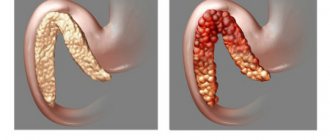Polyps in the stomach are benign tumor-like formations that form from the glandular structure of the mucous membrane of the organ. These tumors appear on the inner wall of the stomach and grow into its lumen. They can have a wide base - sessile tumors and an oblong stalk - lancet tumors. The latter are found at the tops of the mucous membrane, becoming a continuation of its folds. The shape of the tumor is most often round or oval, although mushroom-shaped and papillary polyps are sometimes found. Their color varies from gray to deep red. The more glandular cells a tumor contains, the softer its consistency will be. The average size of the tumor is 15 mm, although sometimes large tumors reaching 60 mm are found.
According to statistics, men are more likely to suffer from this pathology; formations are found in them 2 times more often than in women. The average age at which gastric polyposis is diagnosed is between 40 and 50 years. Single formations are detected less frequently than multiple ones - 47% and 52%, respectively. Diffuse polyposis is extremely rarely detected - no more than 2% of cases. As for the parts of the organ, formations most often appear in the area of the pylorus of the stomach (up to 70% of cases), and, somewhat less frequently, in its body.
Up to 5% of tumor-like formations can lead to cancer. Adenomatous polyps are susceptible to degeneration, which are detected in 20% of cases. The larger the size of the polyp, the higher the risk of its malignancy.
Symptoms of polyps in the stomach
The pathology is manifested by a number of symptoms, which, first of all, depend on its size and histological structure. The smaller the formation, the poorer the clinical signs will be, up to their complete absence.
- Dyspeptic symptoms.
It is this set of signs that most often indicates the presence of a tumor in the organ. The patient suffers from increased gas formation, heartburn, nausea, vomiting and diarrhea, which is often replaced by constipation. The intensity of these signs depends on how long ago the polyp appeared. As the tumor grows, there is an increase in negative manifestations from the digestive tract. All dyspeptic symptoms are manifestations of the pathology against which the polyp formed. Most often, it is they who force the patient to go to see a doctor, after which a tumor is discovered.
- Pain.
Painful sensations in the presence of a tumor are periodic. Mostly they occur after eating, since it is the food that irritates the formation located on the gastric mucosa. The feeling of fullness in the stomach appears due to the fact that due to the polyp its natural volume decreases. The larger it is, the more food that gets into the cavity of the organ stretches it. Such stretching causes painful sensations that occur due to irritation of the nerve endings present in the serosa of the stomach. Depending on the area in which the tumor is located, the time at which pain occurs after the next meal will depend. Immediately after eating, it occurs if the polyp is located high in the cardiac part of the organ. The deeper the tumor is localized, the later the pain will appear - an hour or an hour and a half after eating.
- Bleeding.
The cause of bleeding is most often formations that have a long stalk and are shaped like a mushroom. When it is twisted or injured, blood begins to be released. However, polyps with a wide base can also cause bleeding, which occurs due to their necrosis. The fact that the patient has started gastric bleeding can be suspected by darkened stool, bloody vomiting, a drop in blood pressure and an increase in pulse. Additional signs are unnatural pallor and perspiration. Ignoring the symptoms of bleeding can lead to the development of hemorrhagic shock, which leads to disruption of the functioning of all organs.
- Difficulty evacuating food.
This symptom is observed when the tumor is localized in the pyloric region of the stomach. In this case, food entering the organ cavity does not pass into the duodenum, but stagnates in it. This leads to the development of decay processes. In this case, the patient complains of pain in the epigastric region, he has bad breath, and often foul-smelling vomiting of putrid contents is observed. As the polyp grows, vomiting occurs more often.
- Anemia.
A drop in the level of hemoglobin and red blood cells occurs against the background of prolonged hidden bleeding. It is observed if the polyp is subjected to constant trauma. Since blood loss is quite insignificant, it does not cause a visit to the doctor.
Symptoms of polyposis are very nonspecific and can be easily confused with signs of other diseases, which is why competent help from a specialist is so important in this case.
Traditional methods
Traditional methods should be treated with caution.
You must always remember that any disease cannot be treated on your own; you should definitely consult a doctor. After all, self-medication may not only not help, but may further aggravate the course of the disease.
Therefore, folk methods should be treated with caution and used only in conjunction with treatment under the supervision of a specialist.
You need to talk to your doctor about everything you do so that he can approve it. You should discuss with him the dosage and formulation of all folk remedies. But most often, additional treatment will not be superfluous, therefore, in addition to treatment in special institutions, traditional therapy is used. It has a good effect on the treatment of celandine.
You need to pour one tablespoon of this herb with 200 grams of boiling water and let it steep for about an hour. The resulting decoction should be strained and taken 30 minutes before meals. You can also use propolis. It should be mixed with alcohol and left in a dark place for 7 days.
The tincture should be taken an hour before meals. Be sure to consult your doctor about the recipe, because everything can be selected individually; you should not be treated without the help of a specialist.
In this disease, diet plays a big role. You will have to give up coffee, fried, spicy, salty foods, as well as alcohol. You need to maintain a balanced diet, eat small portions as often as possible. The following products are allowed:
- Boiled vegetables.
- Pasta and porridge.
- Non-acidic fruits.
- Homemade juice or mineral water.
- White bread.
- Dairy products.
- Boiled meat or fish.
- Soups with vegetables or cereals.
Causes of polyps in the stomach
The appearance of formations in the stomach cavity may be due to the following factors:
- Infection with
Helicobacter pillory
, a bacterium that can colonize various parts of the organ and duodenum. Penetrating into the gastric mucosa, it leads to its erosion, causing the development of ulcers, and subsequently, the growth of a polyp. The longer the bacterium exists in the stomach cavity, the higher the risk of malignancy. - Genetic predisposition
to the formation of a precancerous tumor of the stomach. This applies to adenomatous formations.
- Radiation exposure
, namely, ionizing radiation. The mucous membrane lining the stomach is one of the first to respond to radiation fluxes of photons and ions. This factor is confirmed by the fact that in areas where there is an increased level of radiation, the frequency of diagnosing polyps is extremely high.
- Consumption of food containing nitrites and nitrates.
This applies to vegetables, for the cultivation and storage of which various chemicals are used. In addition, all smoked, dried, salted foods, as well as alcohol, have a negative effect on the gastric mucosa.
- Taking medications.
The most dangerous are non-steroidal anti-inflammatory drugs, which can irritate the gastric mucosa, making it more vulnerable and vulnerable.
- Nicotine
, which comes with tobacco smoke, can irritate the epithelial cells of the organ. This, over time, leads to the fact that they begin to degenerate.
- Age.
Every person who has crossed the age of 40 is at risk for the detection of polypous growths in the stomach.
- Diseases of an inflammatory nature.
They cause formations with a fibrous structure to form in the stomach. They are not capable of transforming into cancerous tumors, but can lead to bleeding.
- Diseases of the digestive system.
Gastritis and stomach ulcers are considered the most dangerous in terms of the development of polyps. In addition, with chronic polyadenomatous gastritis, the patient has multiple polyps and cystic growths on the surface of the stomach, which is not a consequence, but a manifestation of the disease.
Polyps in the stomach - is it dangerous?
Any formation in the stomach, even the most insignificant, is dangerous to human health and life:
- Risk of malignancy.
If, after diagnostic measures, it is determined that there is an adenomatous polyp in the patient’s body, then this significantly increases the risk of its subsequent degeneration into a malignant tumor. In addition, it has been established that such formations exceeding 20 mm become malignant in 50% of cases. In this case, they affect not only the diseased organ, but are also capable of spreading throughout the body through metastases. The prognosis is unfavorable, and the mortality rate among those affected is high.
- Pinching of the stem of the formation.
The danger of pinching the leg on which the tumor is located is that the risk of gastric bleeding increases in the absence of emergency medical care. A patient with an injury or torsion of the knives experiences acute pain, which is localized in the epigastric region. If the formation is located near the exit to the stomach and it is pinched, it will interfere with the normal movement of food into the duodenum. This will cause stagnation of food entering the body and vomiting of putrefactive masses.
- Bleeding.
Bleeding can be either massive or latent. Both of these types are dangerous. Excessive blood loss can lead to the death of the patient in the absence of medical care, and hidden bleeding leads to the development of anemia and chronic hypoxia of tissues throughout the body.
- Digestive disorders.
First of all, the danger lies in the inability of food to pass into the intestines. The problem gets worse as education increases. The patient may experience a constant feeling of nausea, loss of appetite, and loss of body weight.
Types of polyps in the stomach
There are many approaches to classifying polyps that form in the stomach.
If we take their morphological structure as a basis, then we can distinguish two types of tumors:
- Adenomatous tumor, which can be tubular, papillotubular and papillary;
- Hyperplastic tumor;
- Xanthoma of the stomach.
In addition, multiple polyps are separately identified that can be inherited: Peutz-Jeghers polyps, Gardner polyps and juvenile polyps. If a patient is diagnosed with one of these forms of polyposis, then the entire area of the stomach will be covered with growths.
Adenomatous polyp of the stomach
If a diagnosis of “adenomatous polyp of the stomach” has been made, then the patient should understand that prompt surgical intervention is necessary. This is due to the fact that it is this type of tumor that is more likely than others to degenerate. The share of such formations in their total mass accounts for no more than 10%. The risk of their degeneration increases as the pathology progresses.
Tubular formation consists of glandular cells, which are externally limited by connective tissue. It is tubular tumors that more often and faster than others degenerate into malignant tumors.
Villous or papillary adenoma of the stomach consists of a layer of the mucous membrane of the organ; it has many finger-like outgrowths of varying widths.
Papillotubular adenoma is a mixed tumor consisting of glandular cells and villous structures. It is an intermediate formation between villous and tubular tumors.
Hyperplastic polyp of the stomach - what is it?
One of the types of formations is hyperplastic polyps. They are more common than others and account for up to 70% of all detected tumors. The term hyperplastic implies that polypous growth occurred as a result of hyperplasia of the epithelial cells of the organ, that is, in its origin there is no mutagenic basis or elements of degenerated cells.
It is extremely rare that formations of this type transform into cancerous tumors. The percentage of degeneration does not exceed 0.5.
Inflammatory and infectious processes occurring in the body lead to the development of hyperplastic polyps. In particular, the vital activity of the bacterium Helicobacter pylori.
As for the prevalence of formations inside an organ, they can be either single or multiple, they can be scattered over its area, or they can gather into nests or merge with each other. The maximum size of such a formation is 60 mm, although sometimes there are huge polyps exceeding this figure.
Although such tumors have a minimal chance of degenerating into a cancerous tumor, they can nevertheless lead to bleeding and stagnation of food.
Juvenile gastric polyps
Such tumors are quite rare and can be detected at any age. Although they are predominantly formed in the first 10 years of a child’s life, which is why they got their name. Juvenile-type polyps most often affect the large intestine, and not just the stomach. Mostly, such formations are diagnosed in the antrum of the organ. The size of juvenile polyps varies from 5 mm to 20 mm.
The structure of a juvenile polyp is represented by elongated convoluted cysts that grow from the inflamed, edematous mucous membrane of the organ. After opening the formation, mucus will be released from it. The same thing happens when pressing on the tumor. Such growths are prone to degeneration into cancer as the pathology progresses. However, with a small amount of them, regression of the disease may occur.
Diagnosis of polyps in the stomach
There are two basic methods for identifying polypous growths in the stomach - endoscopy and x-ray examination. Additional methods include laboratory tests and detection of infection with the bacterium Helicobacter pylori.
- Endoscopic examination.
It comes down to inserting a flexible tube called an endoscope into the organ cavity. There is an eyepiece at its end, which transmits information to the monitor. The doctor gets the opportunity to examine in detail the entire surface of the stomach and determine the presence of polypous growths. Of all the existing options for endoscopic examination, gastroscopy is considered the optimal method for identifying polyps.
The examination takes place in several stages:
- The patient's oropharynx is treated with a local anesthetic.
- A mouthpiece is inserted into the patient's mouth, which he secures with his own teeth. An endoscope is inserted through it into the esophagus, leading it to the stomach. To reduce the gag reflex, a person needs to breathe as deeply as possible.
- Air is supplied through the endoscope, which allows the folds of the stomach to straighten.
- If a tumor is detected, a biopsy is performed.
- The endoscope is removed from the stomach.
Sometimes gastroscopy can be aimed not only at diagnosis, but also at removal of the formation. If a small growth is detected, the doctor may decide to immediately remove it from the body. However, more often only a small area of the polyp is collected for further study.
- X-ray examination.
If for some reason gastroscopy is not possible, then the patient is prescribed an X-ray examination using a contrast agent. In this case, the patient is asked to drink a barium suspension, after which several images are taken using an X-ray machine. They are performed in several projections. Barium is used to obtain better visualization, as the relief of the gastric walls becomes clearer in the images. The procedure should not be performed if the patient is carrying a child, if the patient is in serious condition, has problems swallowing, or is suspected of gastric bleeding. Therefore, gastroscopic examination is the optimal method for not only identifying polyps, but also assessing the condition of the gastric mucosa.
- Non-instrumental
examination methods.
Non-instrumental examination methods include:
- A complete blood count will help identify the presence of hidden bleeding, which can be suspected by low levels of hemoglobin and red blood cells.
- Donating stool to detect hidden blood in it also makes it possible to identify latent bleeding. It is impossible to see minor impurities of blood in stool with the naked eye, since its color does not change. That's why this kind of research is being done.
- Detection of Helicobacter pylori is possible using the PCR method (saliva, blood serum or feces can be used for this), using a breath test, or by cytological and histological examination of the material that was taken during a biopsy.
Answers to popular questions
- Do I need to remove a stomach polyp?
Surgery to eliminate a tumor from the body is not always required. Sometimes it is possible to get rid of a stomach polyp with the help of conservative treatment. A clear indication for removal of an existing tumor is its size exceeding 15 mm. In addition, the polyp should not cause discomfort to the patient or cause complications.
- Can polyps in the stomach resolve on their own?
There is a possibility of independent elimination of a gastric polyp, if the cause that caused it is eliminated.
Kalina
Decoctions are prepared from the beneficial berries of the plant or its leaves.
A few proven recipes:
- Wash viburnum berries (250-300 g), place in a saucepan, add cold water (700 ml). Bring to a boil, keep on low heat for an hour. Cool, strain well with gauze. Drink fruit drink four times a day, 100 ml. To improve the taste, you can add a little sugar. The duration of the procedures is about 6 months.
- Mix berries (200 g) with natural honey (1 tbsp). Leave for 2 hours. Take orally (inside), morning and evening on an empty stomach. Drink the medicine for 2-4 months.
Treatment of polyps in the stomach
Therapy for the formation can be either conservative or surgical. The decision on the method of treatment is made by the doctor based on the results obtained. If a decision has been made to treat the patient with medications, then in parallel the patient must adhere to a certain diet and the principle of fractional nutrition. In addition, periodic monitoring of the condition of the gastric mucosa is important, that is, the patient will need to undergo a gastroscopic examination at least once a year.
Due to the fact that polyps form against the background of various diseases, drug treatment is reduced to taking antacids (to reduce the secretion of gastric juice and protect the stomach from the action of hydrochloric acid.) and omeprazole (restores the gastric mucosa). If Helicobacter is found, antibiotics are prescribed.
If conservative treatment does not achieve the desired result, the patient is sent for surgical treatment.
Oil
If you prepare an oil based on this herb, it can be used later for oral administration using a cotton swab. This procedure will help get rid of intestinal disease. The product is very easy to prepare:
- Fresh or dry celandine is poured into a half-liter container.
- Top with olive or sunflower oil.
- Leave for 7 days and then strain. Add more oil to achieve a ratio of base to cooked (1:1).
Oil with an extract from a poisonous plant is often used to treat tumors on the skin, nose or anus. To do this, after a cleansing enema, you will need to carefully insert a cotton swab, previously generously moistened with oil, into the anus.
Removal of polyps in the stomach
Endoscopic polypectomy
Surgical intervention is carried out using an endoscope inserted into the cavity of the organ. One or another device is passed through it, which destroys or cuts off the existing formation. Endoscopic polypectomy can be of three types:
- Mechanical endoscopic polypectomy
when the tumor is cut off using a metal loop. The cut off formation is removed using an endoscope. This method is dangerous because there is a risk of bleeding.
- Electroexcision.
Most often, this method is used to remove polyps from the stomach. It allows you to remove formations ranging in size from 5 mm to 30 mm, since the selection of a loop for excision occurs on an individual basis.
- Electrocoagulation
allows you to remove a polyp from the stomach using an electric current. For this purpose, biopsy forceps are used, which are applied to the tumor tissue, heat it and cause the pathological cells to evaporate.
Whatever method of endoscopic polypectomy is chosen, it does not guarantee that the growths will not reappear. In addition, there is always a risk of perforation of the organ wall. The procedure cannot be performed in patients with a pacemaker, as well as in cases of impaired blood clotting processes and in serious condition of the patient.
During the operation, the patient is under anesthesia; only after its effect is an endoscope inserted into the stomach cavity and the polypous tissues are destroyed.
Open surgery
The operation is performed using a scalpel. They make an incision, after which the polyp is removed from the stomach. This method of surgical intervention is used if the formation has a size exceeding 30 mm, several fused polypous growths are found in close proximity to each other, and the polyp has a wide stalk.
The course of the operation is as follows:
- The patient is put into a state of anesthesia.
- Tissue is excised layer by layer to gain access to the stomach.
- Using a scalpel, the growths are removed along with the mucous membrane.
- The removed material is sent for histological examination.
- The excised tissue is sutured in layers.
- The patient is brought out of the anesthesia state.
This method of surgical intervention is considered the most dangerous in terms of complications. The wound can become infected, in addition, there is a risk of collapse of the lung tissue, disruption of the heart, the development of pneumonia, thrombosis and intestinal obstruction.
Gastric resection
This method of surgical intervention is the most traumatic and leads to the development of many complications. Therefore, there are strict indications for its implementation:
- The polyp is very large or multiple growths are found.
- Polyps recur repeatedly.
- The tumor has necrosed or its pedicle is pinched.
- Education is the cause of intestinal obstruction.
- There is a high risk of tumor degeneration.
- The polyp has already degenerated into a cancerous tumor.
During the operation, not only the formation is removed, but also part of the damaged organ itself. After the procedure, the patient may experience quite serious complications, among which dumping syndrome comes first. In this case, the patient suffers from severe weakness, nausea and vomiting, and his heart rate increases. The most dangerous complication is oncology of the part of the organ that remains intact after resection.
Diet after polypectomy
After surgery, it is important to follow a diet. This promotes rapid recovery after surgery. General principles of nutrition after endoscopic and laparoscopic surgery:
- The first day after the intervention you will have to fast - food is prohibited
- Second day – the patient is allowed to drink water and special milk formulas
- Third day - 8 weeks switch to an expanded diet
What can be consumed during the rehabilitation period:
- Weak meat broths, soups
- Any porridge
- Milk and lactic acid products
- Stewed, boiled, steamed vegetables
- Sweet fruits and homemade juices
- Paste
- Meat, fish, boiled or baked
The following are prohibited:
- Spicy and fried foods
- Alcoholic drinks
- Smoked meats
- Unpasteurized milk
- Bakery products
- Peas, beans, beans
- Packaged juices
- Sparkling water
- Cabbage and dishes made from it






![Rice. 2. Clinical stigmas of chronic atrophic gastritis [4] 2. Clinical stigmas of chronic atrophic gastritis [4]](https://zakam.ru/wp-content/uploads/ris-2-klinicheskie-stigmy-hronicheskogo-atroficheskogo-gastrita-4-fig-2-330x140.jpg)



